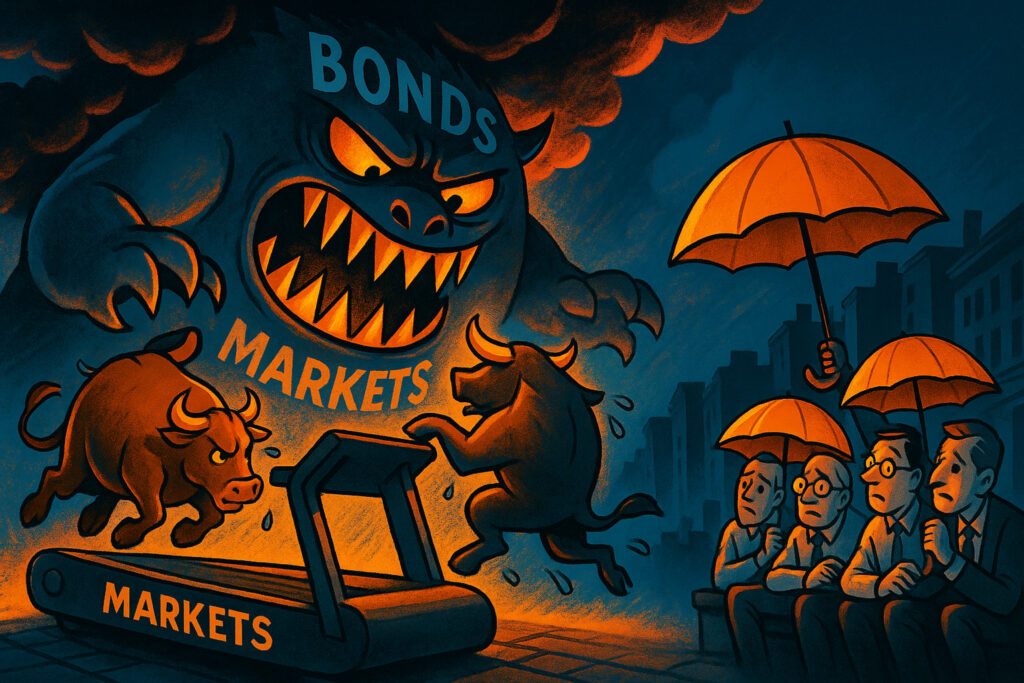Introduction
On 24 September 2025, U.S. equities struggled for direction after a tumultuous start to the week. Following the Federal Reserve’s first rate cut in years and Chair Jerome Powell’s sober reminder that there is “no risk-free path” forward, Wall Street appeared caught in a holding pattern. The S&P 500 wavered near its highs, the Nasdaq fought to recover from its prior day’s decline, and the Dow Jones Industrial Average edged lower.
The story of the day was not dramatic surges or crashes but hesitation. Bond yields pressed higher, gold steadied near records, and energy markets floundered. Traders weighed whether the September rally, which had carried stocks to dozens of new records, still had fuel—or whether the bulls were finally tiring.
Body
Equities: From Surge to Stalemate
The S&P 500 fluctuated throughout the day, unable to reclaim its record from earlier in the week but unwilling to break down. The Nasdaq Composite, after losing nearly 1% the prior session, attempted a mild rebound, buoyed by select semiconductor names and software firms. The Dow drifted lower, dragged by industrial and consumer staples.
Market breadth remained thin. Advancers and decliners were nearly balanced, a stark contrast to the exuberant breadth that characterized the Fed-cut rally a week earlier. Traders were no longer buying indiscriminately; they were reallocating, waiting for clarity.
The message was clear: Wall Street was pausing, not panicking—but the pause itself was telling.
Tech Tries to Regain Its Footing
Technology remained the market’s most watched battleground. Nvidia, Intel, and other chipmakers saw modest gains after sharp profit-taking on 23 September. Alphabet and Microsoft traded mixed, reflecting both AI optimism and concerns about stretched valuations.
Tesla slipped slightly, consolidating gains from earlier in the month. Software names showed resilience, with cloud and cybersecurity firms finding modest inflows.
The attempt at stabilization suggested that investors were not ready to abandon tech leadership but were increasingly cautious about how much further it could stretch without fresh catalysts.
Bond Yields: The Market’s Brakes
The real weight on equities came from bonds. The 10-year Treasury yield ticked higher again, holding firmly above 4.1%. Short-dated yields remained above 4.2%, reflecting the Fed’s cautious tone despite its cut.
The yield curve flattened slightly, reminding investors that while equities wanted to celebrate, the bond market was still demanding a risk premium for inflation uncertainty.
For growth stocks priced on future earnings, rising discount rates are no trivial matter. Each tick higher in yields exerted pressure on valuations, tempering enthusiasm in the Nasdaq.
Gold Holds the Line
Amid the equity hesitation, gold steadied near $3,640 per ounce, consolidating after recent record highs. Powell’s warning had revived demand for hedges, and gold remained a key part of barbell positioning across portfolios.
The metal’s resilience underscored that even as equities flirted with records, investors remained wary of risks—from inflation flare-ups to geopolitical shocks.
Energy Struggles, Oil Directionless
Oil markets provided little comfort. Brent crude hovered just under $79 per barrel, caught between OPEC+ supply discipline and ongoing demand weakness from China. Energy equities underperformed the broader market, reflecting skepticism that crude could provide upside momentum in the near term.
With global growth signals moderating, energy appeared stuck in balance: not collapsing, but not rallying either.
Currency Markets: Dollar Strengthens Again
The U.S. dollar index firmed modestly, reversing its dip from earlier in the week. Higher yields supported the greenback, even as equities showed fatigue.
The euro weakened slightly on soft Eurozone data, while the yen remained under strain amid Japanese fiscal concerns. Emerging market currencies diverged: commodity exporters gained, while capital importers faced pressure from stronger U.S. yields.
Sentiment and Business Activity
The consumer gloom from earlier in September still weighed on the narrative. Sentiment surveys placed households at their lowest confidence levels in months, with inflation expectations rising.
At the same time, business activity reports indicated continued moderation in U.S. growth momentum. Firms reported difficulty passing on higher input costs, compressing margins. While not a crisis, the data pointed to a fragile balance: the economy is not collapsing, but neither is it roaring.
This moderation contributed to the hesitation seen in markets: a recognition that beneath the record highs, the foundation was showing strain.
Investor Psychology: Barbell Posture
The psychology of Wall Street on 24 September was defined by barbell positioning. On one end, investors held onto growth names—technology, AI, semiconductors—hoping that easing would fuel the next leg higher. On the other, they clutched gold, Treasuries, and defensives, hedging against shocks.
Flows into both growth ETFs and gold ETFs told the story: investors wanted exposure to the upside but insurance against disappointment.
The hesitation in equities reflected not weakness but calculation: how much optimism could be justified without fresh clarity from the Fed or new macro data?
Conclusion
24 September 2025 was the market’s day of hesitation. Equities wavered, bonds pressed, gold steadied, oil drifted, and currencies firmed. After weeks of records, the bulls were pausing, the bears waiting, and investors recalibrating.
The day will not be remembered for drama but for what it signaled: that the September rally had reached a point where faith alone could no longer propel it. Powell’s warning echoed. Yields bit. Bulls tired.
Key Questions Ahead
- Will equities regain momentum, or has the rally exhausted itself?
- Can tech stabilize as leader, or will rotation into value and defensives accelerate?
- How far can bond yields rise before equities buckle?
- Will consumer and business weakness feed into corporate earnings, narrowing the gap between Wall Street and Main Street?
On 24 September, markets waited. And in their waiting, they revealed the fragility beneath the triumphs.
